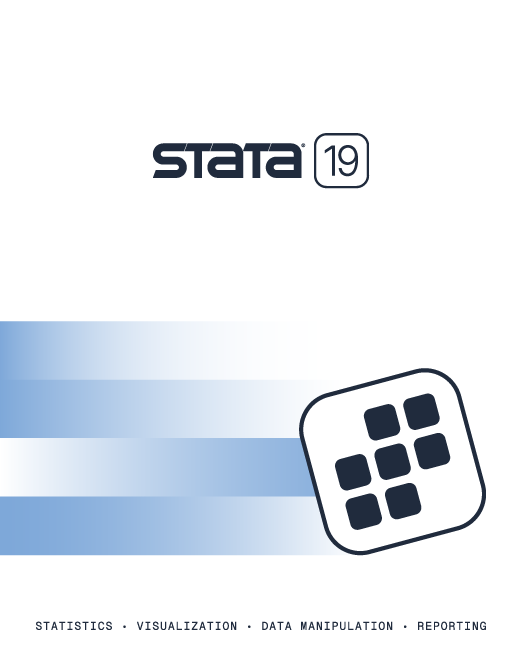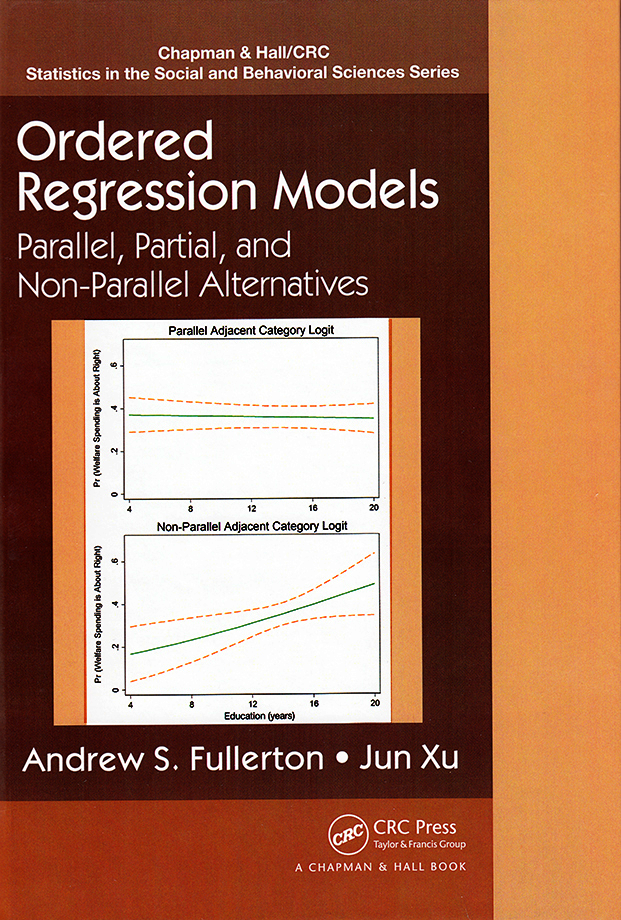

2025 Stata Conference • Nashville, TN • 31 July–01 August
Ordered Regression Models: Parallel, Partial, and Non-Parallel Alternatives |
||||||||||||||||||||||||||||||||||||
 Click to enlarge See the back cover |

As an Amazon Associate, StataCorp earns a small referral credit from
qualifying purchases made from affiliate links on our site.
eBook not available for this title
eBook not available for this title |
|
||||||||||||||||||||||||||||||||||
Comment from the Stata technical groupIn Ordered Regression Models: Parallel, Partial, and Non-Parallel Alternatives, Fullerton and Xu provide a thorough treatment of models for ordinal data. This book will appeal to researchers from any discipline who wish to build on their knowledge of linear, logistic, and probit regression and learn both theoretical and practical concepts related to a variety of models for ordinal outcomes. As the title indicates, the models presented are partitioned into three groups based on whether a parallel regression assumption is made for all covariates, for a subset of the covariates, or for none of the covariates. Under each of these assumptions, the authors describe three models—cumulative, continuation ratio, and adjacent category—from which a researcher can choose, depending on the probability of interest. They also include worked examples with real data and provide advice regarding interpretation, presentation of results, choice of model, and common problems that arise. Example Stata commands for fitting these models are shown at the end of the chapters. |
||||||||||||||||||||||||||||||||||||
Table of contentsView table of contents >> Preface
Authors
1. Introduction
1.1 Ordinal Variables versus Ordinal Models
1.2 Brief History of Binary and Ordered Regression Models 1.3 Three Approaches to Ordered Regression Models
1.3.1 Cumulative Models
1.4 The Parallel Regression Assumption1.3.2 Stage Models 1.3.3 Adjacent Models 1.5 A Typology of Ordered Regression Models 1.6 Link Functions 1.7 Asymmetrical Relationships in Partial and Nonparallel Models 1.8 Hypothesis Testing and Model Fit in Ordered Regression Models 1.9 Datasets Used in the Empirical Examples
1.9.1 Cumulative Models of Self-Rated Health
1.10 Example: Education and Welfare Attitudes1.9.2 Stage Models of Educational Attainment 1.9.3 Adjacent Models of Welfare Attitudes 1.11 Organization of the Book 2. Parallel Models
2.1 Parallel Cumulative Model
2.1.1 A Latent Variable Model
2.2 Parallel Continuation Ratio Model2.1.2 A Nonlinear Cumulative Probability Model 2.1.3 Interpreting the Results from Ordered Regression Models 2.1.4 Example: Parallel Cumulative Models of General Self-Rated Health
2.2.1 A Latent Variable Model
2.3 Parallel Adjacent Category Model2.2.2 A Nonlinear Conditional Probability Model 2.2.3 Potential Sample Selection Bias and Scaling Effects in Stage Models 2.2.4 Example: Parallel Continuation Ratio Models of Educational Attainment
2.3.1 A Nonlinear Adjacent Probability Model
2.4 Estimation2.3.2 Example: Parallel Adjacent Category Models of Welfare Spending Attitudes
2.4.1 Basics of Maximum Likelihood Estimation
2.5 Conclusions2.4.2 Common Problems in the Use of MLE for Ordered Regression Models 2.4.3 Person-Level and Person/Threshold-Level Estimation 2.6 Appendix
2.6.1 Equivalence of Two Parallel Complementary Log Log Models
2.6.2 Stata Codes for Parallel Ordered Logit Models 2.6.3 R Codes for Parallel Ordered Logit Models 3. Partial Models
3.1 Unconstrained versus Constrained Partial Models
3.2 Partial Cumulative Models
3.2.1 Unconstrained Partial Cumulative Model
3.3 Partial Continuation Ratio Models3.2.2 Constrained Partial Cumulative Model 3.2.3 Example: Partial Cumulative Models of Self-Rated Health
3.3.1 Unconstrained Partial Continuation Ratio Models
3.4 Partial Adjacent Category Models3.3.2 Constrained Partial Continuation Ratio Models 3.3.3 Example: Partial Continuation Ratio Models of Educational Attainment
3.4.1 Unconstrained Partial Adjacent Category Models
3.5 Dimensionality in Partial Models3.4.2 Constrained Partial Adjacent Category Models 3.4.3 Example: Partial Adjacent Category Models of Welfare Spending Attitudes 3.6 Conclusions
3.6.1 Guidelines for Choosing a Partial or Parallel Ordered Regression Model
3.7 Appendix
3.7.1 Stata Codes for Partial Ordered Logit Models
3.7.2 R Codes for Partial Ordered Logit Models 4. Nonparallel Models
4.1 The Nonparallel Cumulative Model
4.1.1 Example: Nonparallel Cumulative Models of Self-Rated Health
4.2 The Nonparallel Continuation Ratio Model
4.2.1 Example: Nonparallel Continuation Ratio Models of Educational Attainment
4.3 The Nonparallel Adjacent Category Model
4.3.1 Example: Nonparallel Adjacent Category Models of Welfare Spending Attitudes
4.4 Practical Issues in the Estimation of Nonparallel Models4.5 Conclusions
4.5.1 Guidelines for Choosing a Parallel, Partial, or Nonparallel Ordered Regression Model
4.6 Appendix
4.6.1 Stata Codes for Nonparallel Ordered Logit Models
4.6.2 R Codes for Nonparallel Ordered Logit Models 5. Testing the Parallel Regression Assumption
5.1 Wald and LR Tests
5.2 The Score Test
5.2.1 Example: Cumulative Logit Model of General Self-Rated Health
5.3 The Brant Test
5.3.1 Example: Cumulative Logit Model of General Self-Rated Health
5.4 Additional Wald and LR Tests
5.4.1 Wald and LR Tests Based on a Single Reference Model
5.5 Limitations of Formal Tests of the Parallel Assumption5.4.2 Example #1: Cumulative Logit Model of General Self-Rated Health 5.4.3 Example #2: Continuation Ratio Logit Model of Educational Attainment 5.4.4 Example #3: Adjacent Category Logit Model of Welfare Attitudes 5.4.5 Iterative Wald and LR Tests 5.6 Model Comparisons Using the AIC and the BIC
5.6.1 Example #1: Cumulative Logit Model of General Self-Rated Health
5.7 Comparing Coefficients across Cutpoint Equations5.6.2 Example #2: Continuation Ratio Logit Model of Educational Attainment 5.6.3 Example #3: Adjacent Category Logit Model of Welfare Attitudes 5.8 Comparing AMEs and Predicted Probabilities across Models
5.8.1 Example #1: Cumulative Logit Model of General Self-Rated Health
5.9 Conclusions5.8.2 Example #2: Continuation Ratio Logit Model of Educational Attainment 5.8.3 Example #3: Adjacent Category Logit Model of Welfare Attitudes 5.10 Appendix
5.10.1 Comparisons among the Wald, LR, and Score Tests
6. Extensions
6.1 Heterogeneous Choice Models
6.2 Empirical Examples of Heterogeneous Choice Models 6.3 Group Comparisons Using Heterogeneous Choice Models 6.4 Introduction to Multilevel Ordered Response Regression
6.4.1 Varying Intercepts
6.5 Bayesian Analysis of Ordered Response Regression6.4.2 Varying Slopes 6.4.3 Intercepts and Slopes as Outcomes 6.4.4 Multilevel Nonparallel Ordered Regression Models 6.4.5 Multilevel Ordered Regression Models Using Alternative Link Functions 6.6 Empirical Examples of Bayesian Ordered Regression Models
6.6.1 Bayesian Estimation of the Parallel Cumulative Model
6.7 Conclusion6.6.2 Bayesian Estimation of the Nonparallel Cumulative Model 6.6.3 Bayesian Estimation of the Random Cutpoint Multilevel Stereotype Logit Model References
Index
|
||||||||||||||||||||||||||||||||||||
Learn
Free webinars
NetCourses
Classroom and web training
Organizational training
Video tutorials
Third-party courses
Web resources
Teaching with Stata
© Copyright 1996–2025 StataCorp LLC. All rights reserved.
×
We use cookies to ensure that we give you the best experience on our website—to enhance site navigation, to analyze usage, and to assist in our marketing efforts. By continuing to use our site, you consent to the storing of cookies on your device and agree to delivery of content, including web fonts and JavaScript, from third party web services.
Cookie Settings
Last updated: 16 November 2022
StataCorp LLC (StataCorp) strives to provide our users with exceptional products and services. To do so, we must collect personal information from you. This information is necessary to conduct business with our existing and potential customers. We collect and use this information only where we may legally do so. This policy explains what personal information we collect, how we use it, and what rights you have to that information.
These cookies are essential for our website to function and do not store any personally identifiable information. These cookies cannot be disabled.
This website uses cookies to provide you with a better user experience. A cookie is a small piece of data our website stores on a site visitor's hard drive and accesses each time you visit so we can improve your access to our site, better understand how you use our site, and serve you content that may be of interest to you. For instance, we store a cookie when you log in to our shopping cart so that we can maintain your shopping cart should you not complete checkout. These cookies do not directly store your personal information, but they do support the ability to uniquely identify your internet browser and device.
Please note: Clearing your browser cookies at any time will undo preferences saved here. The option selected here will apply only to the device you are currently using.